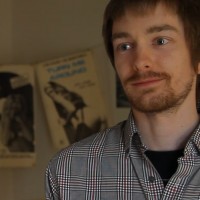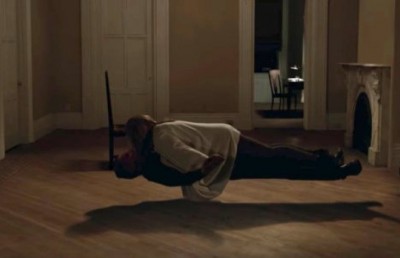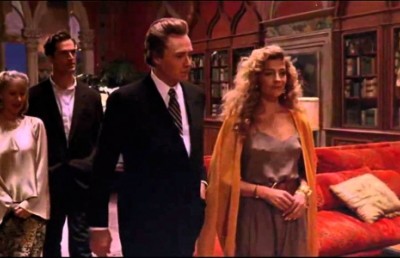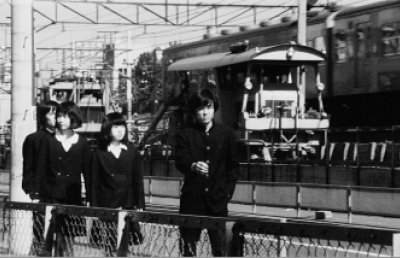Revisiting Paul Schrader’s Transcendental Style in Film

Paul Schrader is an honored guest at this year’s Festival du Nouveau Cinema in Montreal. He will lead a masterclass and have a number of his films screened. It has been a productive year for the legendary filmmaker and author, including a new film and a new edition of his thought-provoking book Transcendental Style in Film: Ozu, Bresson, Dreyer (1972/2018).
Transcendental Style occupies a difficult position in film theory history: it’s situated between the champions of realism (André Bazin, Siegfried Kracauer) and Gilles Deleuze’s Cinema 1 and Cinema 2 (1983, 1985); arrived just ahead of apparatus theory and psychoanalytic film theory; and was published almost the same year as Stanley Cavell’s highly regarded yet under read The World Viewed: Reflections on the Ontology of Film (1971). Transcendental Style also doesn’t fit into typical debates and discussions in film theory – film ontology, realism, affect, and spectatorship – nor does it use philosophical language and jargon. Moreover, the book has perhaps been overshadowed by Schrader’s filmmaking career. For these reasons, and likely many others, the ground-breaking essay hasn’t received the attention it deserves. [[Excerpts fail to appear in Film Studies/Theory Readers. Schrader also doesn’t receive a nod in Thomas Elsaesser and Malte Hagener’s Film Theory: An Introduction through the Senses (New York and London: Routledge, 2010), Gilles Deleuze’s Cinema 2: The Time-Image (trans. Hugh Tomlinson and Robert Galeta, Mineapolis: U of Minnesota P, 1989), or Sarah Cooper’s The Soul of Film Theory (Basingstoke: Palgrave MacMillan, 2013), a volume outlining conceptualizations of “soul” by notable film theorists. See my review, “Lost Souls: The Soul of Film Theory by Sarah Cooper,” Senses of Cinema 78 (2016), http://sensesofcinema.com/2016/book-reviews/the-soul-of-film-theory. Schrader’s investigation of mid-century art cinema masters as extensions of spiritual art is worthy of our careful consideration, especially given the legacy of Yasujirō Ozu, Robert Bresson, and Carl Th. Dreyer. These three directors have been endlessly studied and filmmakers have adopted, revamped, and appropriated them.
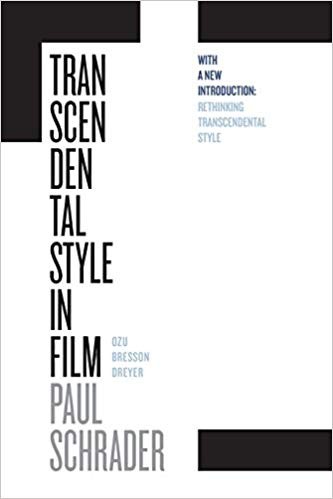
New Edition
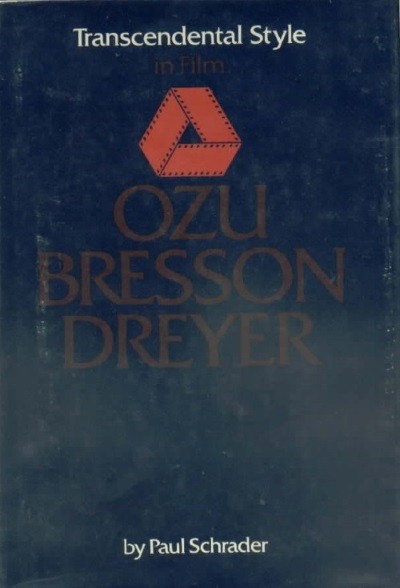
Original Hardback
Transcendental Style is a masterful work of structure, methodology, and art history. Schrader aims for clarity, precision, and simplicity. He begins with a general overview of the theory of transcendental style and a working definition. While moving through several possible definitions, Schrader opts for “human acts or artifacts which express something of the Transcendent,” i.e., an expression of something “beyond normal sense experience” (37) achieved through style or “a general representative form.” The content of a film is therefore unimportant because transcendental style is universal and expressions of the Transcendent “knows no [specific] culture” – any artist can search for this elusive beyond. For Schrader, in terms of filmmaking, what matters are spiritual expressions in cinematography, dialogue, and editing in relation to one or more past iterations of the Holy from the gamut of artistic representation. Schrader connects unrelated filmmakers working in different contexts because they all investigate the “mystery of existence” (42), and it’s the critic’s task to determine, uncover, and reveal how this mystery is expressed.
Transcendental style takes the form of “a repeatable ritual which can be repeatedly transcended” (42). Its filmmakers employ “nonexpressive” tactics, not far from the style of neorealism; neither the filmmaker’s culture nor personality are (directly) expressed in the stylization of the film. Directors choose “irrationalism over rationalism, repetition over variation, sacred over profane, the deific over the humanistic, intellectual realism over optical realism, two-dimensional vision over three-dimensional vision, tradition over experience, [and] anonymity over individualization” (42-3). Within these thematic and stylistic pursuits, the three steps of transcendental style are articulations of the everyday, disparity, and stasis.
The everyday suggests a depiction of the dull and banal (67). Disparity is defined as a visual expression of disunity between the protagonist and their environment, culminating in a “decisive action” (70). This disunity marks the “paradox of the spiritual existing within the physical,” which “cannot be ‘resolved’ by any earthly logic or human action” (108). Then in the decisive action – “a nonobjective, emotional event within a factual, emotionless environment” (74) – the spiritual dimension must be either accepted or rejected by the viewer, concluding in an onscreen representation of stasis, a feature of “religious art in every culture” (76). Stasis provides a view of the world, frozen for contemplation of the Transcendent. Reaching stasis demands careful use of “abundant” and “sparse” means, i.e., articulations of the visible and invisible, the work of everyday life and spirituality. The abundant must not overwhelm (too much religiousness in a film) nor be too sparse (not enough narrative); a film should set the viewer in motion by the end, asking them to enter the image, enter into the Transcendent (179).
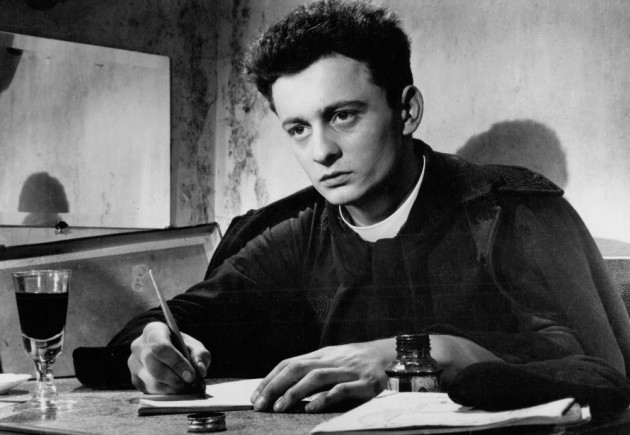
The Diary of a Country Priest, 1951
In a new introduction the author notes that while spiritual and religious themes are not necessary for the style, in practice, most films do pursue them (22). I would suggest here that a film’s negotiation between abundant and sparse means encourages explicit religious themes – it brings the viewer closer to the expression of the Transcendent. On the one hand, many religious films risk overabundance of character identification and escapist dramatization (182). On the other hand, if the film is too sparse in its narrative and technique (e.g., avant-garde cinema), sustaining an audience becomes impossible and the film fails to achieve transcendental style (183).
The three steps of transcendental style form the backdrop of Schrader’s analyses of the three directors. Ozu and Bresson exhibit its triumphs while Schrader considers Dreyer for his interesting attempts to emulate it (and sometimes achieve it). For Schrader, linking Ozu to Zen arts, Bresson to Byzantine iconography, and Dreyer to Gothic architecture assists him in identifying transcendental style in film and its place in art history.
After considering Ozu in relation to Zen arts, Schrader demonstrates the means at the director’s disposable to go beyond it. First, the director shoots the banal and quotidian in static shots from the same low height (as if one is kneeling on the floor). The conversations are monotone and “every cut forthright and predicable” (70). The narratives often reinvestigate everyday themes such as love, marriage, and family, and by employing the same (or similar) locations, actors, and filmmaking techniques, Ozu’s work transforms into a repeatable ritual. Second, for Ozu’s characters, disparity is internal. The protagonists cannot find nature within themselves and the decisive moment (often after the protagonist weeps alone) is a communal event involving family and neighborhood. Third, often after the decisive action at the culmination of a film, Ozu’s camera tracks backwards to reveal the setting, the landscape, and “the unity of all existence” (80). While worthy of the label of transcendental style, Ozu is runner-up to another art cinema master: the French auteur Bresson.
Bresson is the exemplar of transcendental style (167): his form is predictable and is “the operative element,” the subject matter itself simply the vehicle or pretext for expressing the Transcendent. 1 His thematic of confinement and liberty in the prison cycle (Diary of a Country Priest [1951], A Man Escaped [1956], Pickpocket [1959], The Trial of Joan of Arc [1962], and later L’argent [1983]), allows for a productive exploration of “theological questions” (87). Schrader first outlines the presentation of the everyday in Bresson’s cinema by way of plot, actors, cinematography, editing and sound. Each of these components stifles the viewer’s desire to be “distracted” by “screens,” Bresson’s term for something like narrative absorption and character identification. In his non-expressive stylization of the everyday, Bresson “blocks the emotional and intellectual exits, preparing the viewer for the moment when he must face the Unknown” (97). By doubling processes such as an image of an action and a voiceover describing that very same action, the director’s tactics also block the representations of the everyday from becoming “screens” themselves. Second, contrasted with Ozu’s characters, Bresson’s protagonists’ disparity is external, e.g., the titular Priest’s sickness and social and spiritual solitude. Third, after the decisive action, Bresson ends with stasis that generally take shape as an icon, e.g., the charred stake after Joan’s execution. It is this recourse to iconicity that takes Schrader into the realm of Byzantine iconography. The remainder of the chapter is a lively exploration of this form of art and the director’s possible Jansenism.
Unlike the aforementioned auteurs, Dreyer doesn’t completely master transcendental style (134), but the Danish director’s oeuvre helps Schrader further delineate its parameters. Dreyer approaches transcendental style “componentially,” sometimes successfully integrating it into his Kammerspielfilm (essentially a slow-paced chamber drama) and expressionist aesthetic. Those familiar with Dreyer’s most famous film, The Passion of Joan of Arc (1928), would presume its inclusion within Schrader’s categorization of art film. However, in this film, Schrader demonstrates how transcendental style and expressionism vie for control over the Kammerspiel (144). Here, the author excellently contrasts Bresson’s Joan and Dreyer’s Joan, and this analysis extends our understanding of the former’s status as exemplary transcendental filmmaker. The closest Dreyer comes to transcendental style is Ordet (1955) but, throughout his career, Schrader notes, Dreyer foregoes stasis. The author does praise Dreyer’s mise-en-scène, linking it to Gothic architecture, which allows the director to express humankind’s “existential disparity in an agonizing, unflinching manner” (164).
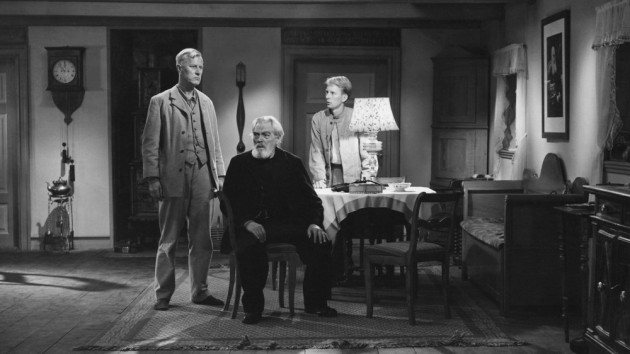
Ordet, 1950
With these three chapters of Transcendental Style in hand, Schrader concludes that “Spiritual art must always be in flux because it represents a greater mystery, also in flux: man’s relationship to the Holy” (185). As of 1972, Ozu and Bresson best fulfilled the task of expressing the Transcendent.
Schrader’s text is formidable and convincing. He makes a strong case for Ozu, Bresson, and Dreyer’s inclusion within the history of spiritual art and for transcendental style more generally as a key concept in the field of spiritual art history. The author sidelines debates about film as entertainment or art by unrelentingly pursuing the latter direction. It isn’t that film is an art because it requires a vast array of skills and techniques – it’s art by virtue of its explorations of ontological themes that have, since time immemorial, preoccupied artists, philosophers and theologians. Finally, for a young author (he was 24 when the book was published), Schrader writes as if he was a seasoned scholar.
At the end of the original edition, the author states that transcendental style “operates in time” (177). Following up on this remark, the notable addition to the new edition is an introduction penned by Schrader in 2016 about Deleuze, Andrei Tarkovsky, and slow cinema. He differentiates the latter mode from the preoccupations of Ozu and Bresson, yet notes that a number of slow cinema directors (e.g., Carlos Reygadas, Bruno Dumont, Pawel Pawlikowski) utilize transcendental style mechanics (21). Schrader provides his own gloss on the mode and its techniques, then demarcates the possible “directions” of slow cinema: freed from the narrative function, the surveillance camera film hyperbolically focuses on the quotidian (Jeanne Dielman, 23 quai du Commerce, 1080 Bruxelles [Chantal Akerman, 1975], Tsai Ming-liang); the art gallery film presents light, color, and abstraction (Michael Snow, Stan Brakhage); and the mandala film heads towards meditation and inaction (Andy Warhol, Abbas Kiarostami). These directions give slow cinema scholars superb conceptual and technical terms to work with in future studies.
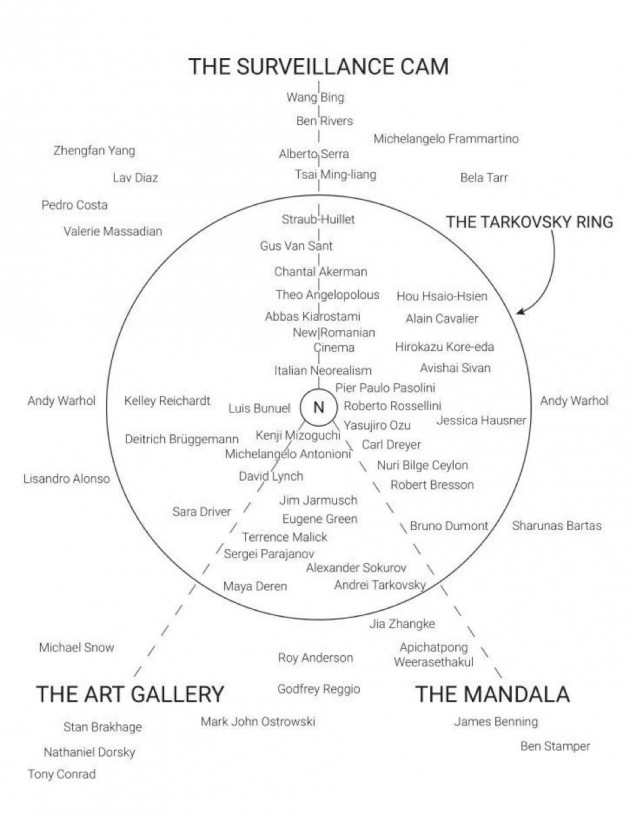
Although it’s possible to apply a transcendental style to any number of directors, Schrader’s new introduction confirms that it only functions for a select few. While it may be the case that transcendence is ultimately “in the eye of the beholder,” it’s also true that “transcendental style directors are deceptively difficult to emulate” and “faux uses” abound (22). (I appreciate the brief criticism of Lars Von Trier’s Breaking the Waves [1996] here.) This being said, the author’s new concluding diagram on the three prongs of non-narrative/slow cinema will surely become an excellent touchstone for art cinema scholars. With the reedition of Transcendental Style, perhaps we will see an increase in engagement with this somewhat lost text of film theory.
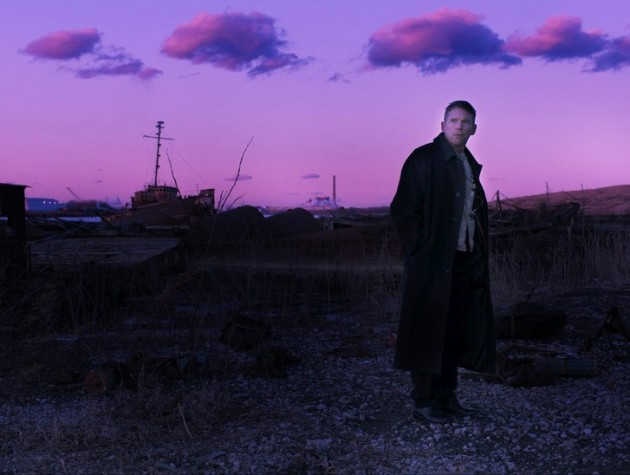
First Reformed
The reedition of this 46-year-old study of the Holy in art cinema also appears alongside the theatrical release of Schrader’s most transcendental film yet (and his first overtly religious one). First Reformed (2017) stars Ethan Hawke as Rev. Ernst Toller, an upstate New York Protestant minister in an existential crisis who, like the titular protagonist of Bresson’s Diary of a Country Priest, scribbles his thoughts into a personal notebook. The film has received excellent reviews. 2 NY Times’s A.O. Scott called it an epiphany, “the portrait of a soul in torment, all the more powerful for being so rigorously conceived and meticulously executed.” 3
Featured image from First Reformed
Notes
- In 1976, Schrader interviewed Bresson. He asked if the director had seen Ozu’s films, to which Bresson replied: “No, I don’t go any more to see movies. I may have seen one a long time ago.” Paul Schrader, “Robert Bresson, Possibly,” in Robert Bresson: Revised, ed. James Quandt, Toronto: Tiff, 2011, 703. ↩
- Sean Nam, “Hungering and Thirsting for Righteousness: An Interview with Paul Schrader,” Cineaste 43.3 (2018), 19. ↩
- A.O. Scott, “Review: ‘First Reformed’ Is an Epiphany. Ethan Hawke Is, Too.,” NY Times, 17 May, 2018 https://www.nytimes.com/2018/05/17/movies/first-reformed-review-paul-schrader-ethan-hawke.html. Whether the theorist of transcendental style successfully deploys it in First Reformed is a question for another article, but at least one critic positions the film within the tradition. [[Aliza Ma, “First Reformed,” Film Comment 54.3 (2018), 69. Nam asks Schrader if First Reformed is a work in the transcendental style, but Schrader doesn’t provide an answer. Instead, the director quickly summarizes the introduction to the new edition of Transcendental Style. Nam, “Hungering and Thirsting,” 21. ↩

